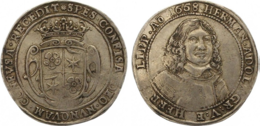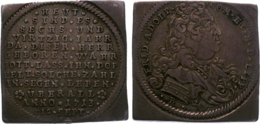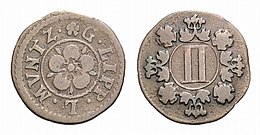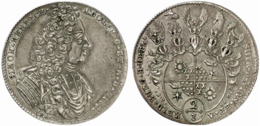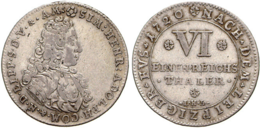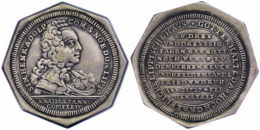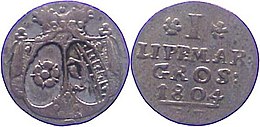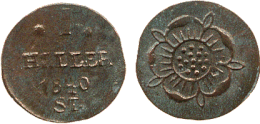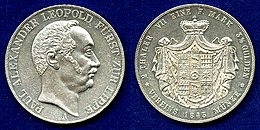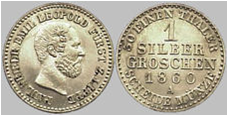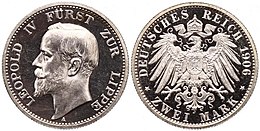Lippe coin history

until 1919
The Lippe coin history describes the coinage in Lippe up to the time of the First World War in 1918.
history
Lippe was a German state, the rule of the Lippe lords was first recorded in the 12th century. In 1528 the rule of Lippe was elevated to an imperial county and in 1789 to a principality .
Until 1806 Lippe was a territory in the Lower Rhine-Westphalian Circle of the Holy Roman Empire , from 1806 to 1813 part of the Rhine Confederation , from 1816 to 1866 part of the German Confederation , from 1866 a member of the North German Confederation , from 1871 part of the German Empire . After the end of the First World War, in 1919, Lippe was a democratically constituted Free State in the Weimar Republic . In 1947/1948, at the instigation of the British occupying forces , the state of Lippe had to give up its centuries of independence and decided to join the state of North Rhine-Westphalia, which was founded in 1946 .
The area of the former state of Lippe in its last territorial status largely corresponds to today's district of Lippe in the administrative district of Detmold , both of which are the administrative seat of Detmold. Along with Westphalia and the Rhineland, the Lippe district forms the third and by far smallest part of the state of North Rhine-Westphalia .
Regents
In 1789 the absolutist ruling counts were elevated to the rank of prince, making the country a principality. The princes were prevented from fully developing their absolutist power due to the small size of the country and the resulting limited sovereignty, for example in military matters, and also due to the strong position of the estates. A state parliament was convened as early as 1836 and the power of the princes was restricted by a constitution. The princes came from the noble House of Lippe , whose first chief was mentioned in 1123. Most of the princes came from the Lippe-Detmold line. After violent inheritance disputes, the reign was initially transferred to the Schaumburg-Lippe line (but the states of Schaumburg-Lippe and Lippe were only connected and not united), and finally to the Lippe-Biesterfeld line, which until then had no territory of its own. The last prince abdicated in the November Revolution of 1918, but was still allowed to live in Detmold Castle . The descendants of the last prince call themselves Prinzen zur Lippe. You still live in Detmold Castle today. The current head of the family has been Stephan Prinz zur Lippe (* 1959) since 2015 .
| Bernhard VII. | Simon V. | Bernhard VIII. | Simon VI. | Simon VII | Johann Bernhard | Hermann Adolf | Simon Heinrich | Friedrich Adolf |
|---|---|---|---|---|---|---|---|---|

|

|

|

|

|

|

|

|

|
| Simon H. Adolf | Simon August | Leopold I. | Leopold II. | Pauline | Leopold III. | Woldemar | Leopold IV. |
|---|---|---|---|---|---|---|---|

|

|

|

|

|

|

|

|
Transition to national single currencies
In the High Middle Ages, the right to mint coins was a privilege that every nobleman sought, because the coin shelf was a profitable sovereign right . This meant that there were many non-comparable currencies, as the fineness of the individual types of coins could fluctuate greatly. Because in the Middle Ages Kurant coins were common, the market value of a foreign coin was determined based on the precious metal content. This in turn prevented supra-regional trade. For these two reasons - trade facilitation and concentration of power - the tendency towards national single currencies increased.
In the early days of Kurantgeld , the metal content of the coins corresponded to their face value. However, since the minters were more often tempted to deteriorate coins in order to cover their money needs, inflation occurred several times in the early modern period . For example, the so-called Kipper and Wipper time at the beginning of the Thirty Years War was based on a deterioration in coins.
The driving force in Europe was France, which with its central government collected the minting rights early on and made them subject to the king. The first major currency reform was the great coin reform under Louis XIII. in 1640 and 1641 when the Louis d'or was introduced. With the introduction of the French franc in 1795, the first decimal currency was established. This currency and especially its decimal denominations were spread throughout Europe through Napoleon's campaigns. This resulted in a number of coin systems in and around France that were structured in a similar way and that formed fixed exchange rates because of the high purity currant coins . This led to the creation of the Latin Monetary Union on December 23, 1865 ; it was a currency union that consisted of France, Belgium, Italy, Switzerland and Greece and gave clear guidelines for the manufacture of coins. The disadvantage of the Latin Coin Union was bimetallism , i.e. the fixed exchange rate between gold and silver coins.
Mints, Mint Masters and Wardeins
The responsible manager of a mint was the mint master . He was either part of the mint's wages or he ran the mint as a leaseholder. The control of the quality of the coins and the minted goods of a mint was the responsibility of an official, the wardein .
Mints
Blomberg Mint
In Blomberg , the Mint of the noblemen of Lippe under Bernhard III was. (1229 to 1265) and Simon I (1275 to 1344). Pfennigs ( sterling ) are preserved, minted after the English model under Simon VII between 1610 and 1618 (thalers and groschen with Lippe coat of arms) and under Paul Alexander Leopold in 1821 and 1827 to 1840 (copper money with Lippe coat of arms and value).
Mints Detmold
The Detmold mints in the castle, in the upper mill and in the Bokemühle were from 1598 to 1811, with the exception of the years 1610 to 1618, the Count's Lippe mint. Were minted gold - silver - and copper coins in numerous values.
Horn Mint
Documentary reports about the granting of minting rights to the noble lords of Lippe or about minting activity in the Horn mint have not survived, nor have any Horner coins from the early period after the establishment of the mint emerged. According to the known material, the beginning of the coinage can only be set in the period between 1280 and 1290. Horn was the mint of the Lords of the Lippe under Simon I (1275-1344), here pfennigs were produced on Wiedenbrücker stroke and also those based on the model of the English Edward sterling . The earliest documented mentions of Horner Pfennige can even be found in documents from the 14th century .
Lemgo Mint
In Lemgo the Mint of the noblemen of Lippe from the early 13th to mid-14th century was. This included the important, so-called Wessele (= exchange bank ). Initially, pennies were minted in Soester and Paderborn (Brakeler) strokes, then after the English model (sterling). Furthermore, under Bernhard VII. (1431 to 1511) in Lemgo Stüber and smaller values with the Lippe coat of arms. Minting in 1528 under Simon V also probably took place in Lemgo (oldest Lippe thaler with a portrait and coat of arms of the count; hollow pennies ). After all, the Lippe copper money was produced here from 1812 to 1825.
Berlin Mint
In the Berlin Mint (mint mark = "A"), the imperial coins, which were also valid in Lippe, were minted from 1843 to 1913, including the gold mark introduced throughout the German Empire in 1875 . The front, the obverse , could be designed by the member states of the empire. In Lippe they showed the portrait of the ruling prince.
Mint master
| Period | Surname | Others |
| around 1295 | Hermannus filius Heinrici monetarit | |
| around 1306 | John Monetarius | |
| around 1324 | Heynricus dictus monetarius | |
| around 1497 | ? Lockpick | Mint master of Neuss |
| 1528 | Gerhard Loess | also Lohaus |
| 1595 to 1601 | Peter Busch | previously mint master at Bielefeld |
| 1601 to 1602 | Caspar Huxer | from Münden, responsible for the minting of the county of Waldeck from 1590 to 1596 , † 1628 |
| 1602 to 1605 | Henning Hansen | from Osterode am Harz , previously in the service of the city of Hildesheim , active in northern Germany after 1605 |
| 1605 to 1608 | Engelhard Hausmann | also Engelbert ; previously in the service of the Landgrave of Kassel , from 1608 mint master of the Werl mint |
| 1608 to 1610 | Christoph Dyß the Younger |
active in the Blomberg mint, previously in the service of the Counts of Regenstein and the city of Hameln (1606–1608); from 1611 mint master in the Peine mint , † December 1611 |
| 1610 to 1616 | Caspar Kohl | from Vienna ; active in the Blomberg Mint; 1620–1621 and from 1635 mint master of the County of Holstein-Schauenburg |
| 1616 to 1618 | Melchior cabbage | |
| 1618 to 1619 | Jakob Pfahler | * 1568 in Saalfeld |
| 1619 | Melchior Kuttner | probably came from near Schwäbisch Hall |
| 1620 to 1621 | Ipo Rizema | until 1616 mint master in Bremen |
| 1621 to 1623 | Melchior Kuttner | |
| 1636 to 1639 | ||
| 1644 to 1658 | Michael Kuttner | |
| 1658 to 1660 | Christoph Henning Schlueter | previously in Braunschweig-Lüneburg , Goslar and Zellerfeld |
| 1671 to 1695 | Johann Hoffmann | from Rinteln |
| 1710 to 1716 | Hans Lüders | previously mint master in Hildesheim , Mmz. "HL", † 1716, buried on May 4, 1716 |
| 1717 to 1727 | Ludolph Henrich Lüders | Son of Hans Lüders |
| 1763 to 1768 | Johann Conrad Bandel | * around 1703 in Kassel , † in December 1768; Initials: ICB |
| 1769 to 1787 | Henrich Daniel Stümer | † August 12, 1787 |
| 1789 to 1811 | Johann Balthasar Reinhard | * ~ 1730 in Kassel, † August 11, 1816 in Detmold |
| 1791, 1792, 1796 | Theodor Stockmar | Mint master in Gotha |
| 1812 to 1825 | Jobst Henrich Trebbe | * Jan 28, 1807 in Lemgo; Coppersmith in Lemgo, Mmz. "T." |
| 1821 to 1840 | ? Strickling | Mechanic in Blomberg, Mmz. “ST.”; Strickling also manufactured fire engines , among other things |
Note: 1) Some sources assume only one person, Caspar Melchior Kohl.
Coin administrators, coin directors, coin overseers, chamber councilors, trainee lawyers and assessors for the Lippe coinage
| Period | Surname | Others |
| 1594 to 1598 | Johannes Kotzenberg | also Johan Kötzenberger |
| 1610 to 1618 | Johan Tecklenburg | |
| 1618 to 1619 | Dietrich Witte and Meyer Wallich | |
| from 1620 | Hans Adam von Hammerstein | * 1579 or July 19, 1571 in Öge, Hückeswagen office; † February 10, 1653 in Altenbruchhausen |
| 1656 to 1658 | Johan Kuttner | |
| 1661 to 1669 | Hans Georg mortar | |
| 1710 to 1729 | ? Boht | Chamber Council / Mint Commissioner / Mint Director |
| 1763 to 1765 | Lieutenant Knoch | Mint director |
| 1763 to 1772 | ? helmet | Coin Commissioner |
| 1784 to 1796 | Georg Karl Stein | Chamber Council, Head of the Mint Department |
| from 1796 | ? Meineke | Chamber Council, Head of the Mint Department |
| from 1798 | Johann Christian Gerke | Assessor; as road construction commissioner, among other things, responsible for the coinage |
| 1803 to 1826 | Johann Christian Gerke | Chamber Council |
| 1826 to 1839 | Wilhelm Georg Stein | Referendarius, head of the coin department |
| from 1839 | Wilhelm Georg Stein | Chamber Council |
Wardeine
| Period | Surname | Others |
| 1595 to 1598 | Christoph Draubel | |
| 1600 to 1602 | Alexander Wackerwald | |
| 1604 to 1605 | Ernst Schröder | |
| 1605 to 1608 | Burckhardt Lachtorp | |
| 1608 to 1619 | Henning Brauns | |
| 1619 to 1623 | Jobst Brauns | |
| 1711 to 1713 | Johann Heinrich Siegel | |
| 1715 to 1717 | Ludolph Heinrich Lüders | from 1717 to 1727 mint master (see above) |
| 1763 to 1769 | Heinrich Daniel Stümer | from 1769 to 1787 mint master (see above) |
| 1789 to 1811 | Johann Balthasar Reinhard | from 1789 to 1811 mint master (see above) |
Weights, coin feet and counting method
Weights according to the Cologne mark
- Up to July 1838: 1 Cologne mark ~ 233.9 g
- July 1838 to 1857: 1 Cologne mark = 233.855 g
- 1 Cologne Mark in German division = 16 Lot = 288 Grän
- 1 Cologne mark in French division = 12 Pfennig = 288 Grän
- 1 Cologne mark as gold weight = 24 carats = 288 grän
Coin feet
A coin meter is an official determination of a mint owner how many coins of one type should be struck from a unit of weight of precious metal ; it determines the amount of a precious metal ( fineness ) that a certain coin should contain.
- Coin base of the gold guilder
- With a rough weight of 3.25 g and a fine weight of 2.50 g, the proportion of fineness = 77.1%
- Coin base of the ducat according to the Imperial Coin Order of 1559
- With a rough weight of 3.49 g and a fine weight of 3.44 g, the fineness was 98.6%
- The old Louis d'or's coin base
- With a rough weight of 6.751 g and a fine weight of 6.191 g, the fineness was 91.7%
- Coin base of the matched Louis d'or according to the Vienna Treaties 1753
- 1 Louis d'or = 5 Reichstaler
- Value of the crown according to the Vienna Mint Treaty of July 4, 1857
- With a rough weight of 11.111 g and a fine weight of 10,000 g, the fineness was 90.0%
- Coin base according to the Imperial Coin Order of 1524
- The fineness of one Reichsguldiner (27.4 g) and one Reichstaler (29.2 g) corresponded to a fineness of 93.7%
- Coin base according to the Imperial Coin Order of 1566
- The fineness of a Reichstaler from the Feine Kölner Mark (25.984 g) and one Reichstaler from the Rauen Mark (29.232 g) corresponded to a fineness of 88.9%
- The fineness percentage of a bill thaler from the fine Cologne Mark (22.272 g), 2/3 thaler (14.848 g) and weighed rough weights (18.5 to 19.5 g) corresponded to a fineness percentage of 75.0%
- Coin base according to the Treaties of Leipzig and Torgau 1690
- The fineness of a bill thaler from the fine Cologne Mark (19.488 g), the fineness of the embossed 2/3 thaler (12.992 g) and the rough weight of the 2/3 thaler (17.322 g) corresponded to a fineness percentage of 75.0%
- Coin base according to the Vienna Treaties of 1753:
- The fineness of a bill thaler from the Feine Kölner Mark (17.539 g), the Convention thaler from the Feinen Kölner Mark (23.386 g) and the rough weight of the Convention thaler (28.062 g) corresponded to a fineness of 83.3%
- Coin base for club coins according to the Dresden Convention of July 30, 1838
- The fineness of a thaler from the fine Cologne mark (16.704 g), club coin from the fine Cologne mark (33.408 g) and the rough weight of the club coin (37.120 g) corresponded to a fineness of 90.0%
- Coin foot of the silver groschen according to the Lippe state ordinance of September 1, 1846
- The fineness of a thaler from the fine Cologne mark (14.616 g), silver groschen of 6 lots from the fine Cologne mark (1.218 g), silver groschen of 5 lots from the fine Cologne mark (0.487 g) and silver groschen of 4 lot from the fine Cologne mark
- The coin base of the Vereinstaler according to the Vienna Mint Treaty of January 24, 1857
- The fineness of the Vereinstaler from one pound of fine silver (16.667 g) and the rough weight of the Vereinstaler (18.518 g) corresponded to a fineness of 90%
- Coin foot of the silver groschen according to the Lippe state ordinance of April 3, 1858
- The fineness of 1/2 thaler from a pound of fine silver (14.492 g), 1/2 silver groschen (1.208 g) and one silver groschen (0.483 g)
Counting according to the Lippe coinage rate
| ↓ Period unit → | Valleys | mark | Like | Kör | Pfg | Gos | Sig | Reg | aMg | aRg | SwG | Add | Sch | Mat | Hel |
| 1555 | 1 = | 36 | 108 | 432 | |||||||||||
| 1598 to 1620 | 1 = | 36 | 288 | 432 | 24 | ||||||||||
| Aug 20 to Sep 7 1620 | 1 = | 336 | 672 | 42 | 63 | ||||||||||
| Sep 7 1620 to Nov. 1, 1622 | 1 = | 42 | 252 | 504 | 36 | 63 | |||||||||
| 1620 to 1621 | 1 = | 252 | 21st | ||||||||||||
| Nov 1, 1622 to 1640 | 1 = | 36 | 252 | ||||||||||||
| 1640 to 1765 | 1 = | 36 | 216 | 72 | 12 | ||||||||||
| March 1, 1765 to December 31, 1846 | 1 = | 6th | |||||||||||||
| Jan. 1, 1847 to June 24, 1857 | 1 = | 360 | 30th | ||||||||||||
| June 24, 1857 to December 4, 1871 | 1 = | 360 | 30th | ||||||||||||
| from Dec. 4, 1871 | 1 = | 100 |
Note: Mag = Mariengroschen , Kör = Körtlinge ("Kurzgroschen"), Pfg = Pfennige , Gos = Gosler, Sig = Silbergroschen, Reg = Reichsgroschen, aMg = old Mariengroschen, aRg = old Reichsgroschen, SwG = Heavy Groschen, Füg = Fürstengroschen, Sch = Schillinge , Mat = Matthier , Hel = Heller
Timetable
For a long time, the right to mint coins was reserved for the king or emperor alone. It was not until the time of Ludwig the Pious (814–840) that the first minting rights were first known, initially only to archbishops , bishops or abbots . For the Westphalian region, the first award in the year 833 to the Corvey monastery is documented. Up to the 11th century , only the episcopal mints in Paderborn and Minden, the mints of the Corvey , Helmarshausen and Herford abbeys and the royal and archbishopric Cologne mint in Soest can be mentioned in the Lippe neighborhood .
DOMINATION AND COUNTY LIPPE
Hermann (until 1123)
The nobleman Hermann zur Lippe (* 11th century; † before 1123) was the ruler of the Lippe rulership and is the first tangible ancestor of the Lippe princes and later Queen Beatrix of the Netherlands.
Bernhard I. (1123 to around 1158)
Bernhard I († around 1158), son of Hermann, is one of the earliest representatives of the noble "Herren zur Lippe". The first documented mention of this family is dated to 1123, in which "Bernhardus de Lippe" is mentioned by name. Since after his death around 1158 the rule was taken over by his brother Hermann , it can be assumed that Bernhard had no descendants.
Hermann I. (around 1158 to around 1160)
Hermann I († around 1160) and his brother Bernhard founded a Premonstratensian monastery in Cappel around 1139 . After Bernhard's death in 1158, he took over his dominion, which was later to become the city of Lippstadt . He was a loyal follower of Henry the Lion . He owed his ascent to him: Hermann became Vogt of the Cappel Monastery, which had been founded, and was also Vogt of Busdorf and Schötmar .
Bernhard II. (~ 1168 to 1196)
Bernhard II zur Lippe (* around 1140 at Lipperode Castle ; † 1224 in Mesothen ) was the founder of the rule of Lippe and the planned cities of Lippstadt (1185, according to other sources as early as 1184) and Lemgo (1190). In the course of his life he developed into one of the most important and influential Westphalian personalities of the Staufer period . All sovereign and special rights of the "Herren zur Lippe" are probably due to him.
Hermann II. (1196 to 1229)
Hermann II (* 1175 in Lippe, today Lippstadt; † April 25, 1229) was co-regent of his father and followed him in 1196 as regent of the house of Lippe. Less warlike than his father and brother, he often tried to act as a mediator in his area. In the war of the German throne in 1198, Hermann stood on the Guelph side and did not go over to Emperor Friedrich II until 1214 .
Minting of coins from Lippe began under Hermann II.
| Face value: 1 pfennig on Soest strike | |

|
Mint: Lippstadt |
| Issue: around 1200 | |
| Material:?; Weight = 1.22 g; Diameter =? | |
| Obverse: Archbishop with miter , flag and crook | |
| Reverse: cross with Soester symbol in the first corner and a ball in each of the other corners | |
Bernhard III. (1229 to 1265)
Bernhard III. (* around 1194; † around 1265) succeeded the fallen father as regent of the house of Lippe in 1229 and called himself "Statutum in favorem principum" since then, then in 1232 "by the grace of God" and at times also "Count". Through frequent feuds, the Lippe house was severely weakened (financially) under his leadership.
The coins of Bernhard and his son Bernhard IV cannot be distinguished. The motifs of the minted pennies were based on the models of both neighboring areas, for example the Episcopal Paderborn mints Brakel and Warburg, as well as English Steirlinge .
| Face value: 1 pfennig | |
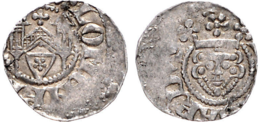
|
Mint: Blomberg |
| Edition: between 1229 and 1265 | |
| Material:?; Weight = 1.04 g | |
| Front:? | |
| Back:? | |
Bernhard IV. (1265 to 1273)
Bernhard IV. (* Around 1230 in Brake , today Bielefeld ; † June 1275) inherited his brother Hermann III. zur Lippe around the city of Lippstadt and took part, together with his uncle, Bishop Simon I of Paderborn , in the battle of Zülpich against the Jülich family , in which his uncle was taken prisoner. Bernhard triggered it in 1269 and thus established the Lippe family's indebtedness.
| Face Value: 1 Pfennig (Sterling) | |

|
Mint:? |
| Edition: 1268 | |
| Material: silver; Diameter:?; Weight: ? | |
| Front:? | |
| Back:? | |
Simon I (1273 to 1344)
Under the reign of Simon I (* around 1261; † August 10, 1344) the rule of Lippe acquired, among other things, he acquired the Varenholz Castle and the Gogericht Langenholzhausen , their largest territorial extent.
Otto (1344 to 1360)
Otto was Herr von Lippe from 1344 to 1360. After the death of his father, the rule of Lippe was divided so that Otto got the area around Lemgo and his brother Bernhard V the area around Rheda . Otto resided in Lemgo, which at that time still consisted of two cities (old town and new town) that only merged five years after his death.
Simon III (1360 to 1410)
Simon III (* around 1340; † 1410) first pledged the towns of Barntrup and Salzuflen as well as Schloss Sternberg under his rule, and in 1405 the entire county of Sternberg followed .
Simon was married to Ermengard von Hoya and had seven children. Bernhard , her eldest son, became Simon's successor.
| Face value: 1 pfennig | |

|
Mint:? |
| Edition: between 1360 and 1410 | |
| Material:?; Diameter:?; Weight: ? | |
| Front:? | |
| Back:? | |
Bernhard VI. (1410 to 1415)
Bernhard VI. (* around 1370; † 1415) married Margarethe von Waldeck - Landau in 1371 . Around 1380 Bernhard married Margarethe von Mörs for the second time . His second marriage son, Simon , succeeded him.
Simon IV (1415 to 1429)
Simon IV. Zur Lippe († August 11, 1429), born around 1404, claimed in 1424 in a feud with Count Adolf IX. von Schaumburg took over the county of Sternberg and later had a hunting lodge with a moat built in Osterholz.
Bernhard VII (1429 to 1511)
Bernhard VII (* 1429 - † April 2, 1511) was the sovereign of the Lippe dominion . Because of many bloody feuds in which he was involved, he was also called " Bellicosus ".
Until 1446 he was under the guardianship of his uncle Otto, then of Cologne Archbishop Dietrich II von Moers . In 1444 he signed a contract with Duke Adolf von Kleve-Mark , according to which he ceded half of the town of Lippstadt , which had been pledged up to that point . At the same time, an alliance was established between the two houses, which Bernhard involved in the so-called Soest feud with Archbishop Dietrich of Cologne. The latter called a Bohemian army to help in 1447, which devastated the Lippe region, but besieged the cities of Lippstadt and Soest in vain.
After the dispute was settled in 1449, Bernhard initially lived at Blomberg Castle . In 1468 he chose Detmold , at that time the smallest of the Lippe towns with around 350 inhabitants, as his permanent residence. An inscription in the old castle tower of Detmold Castle with the year 1470 reminds of the subsequent reconstruction of the castle .
Bernhard fought his feuds with changing opponents and allies. In 1469, he gave Landgrave Ludwig II of Hesse assistance against his brother Heinrich III. , but on the other hand was one of the most important pillars of his brother Simon , the prince-bishop of Paderborn , against Landgrave Ludwig II during the Hesse-Paderborn feud that broke out in 1464 because of the Calenberg Castle and lasted until 1471 .
| Nominal: 1 cross egg | |

|
Mint:? |
| Edition: 1505 | |
| Material: silver; Diameter:?; Weight: ? | |
| Front:? | |
| Back:? | |
Simon V (1511 to 1536)
Simon V zur Lippe (* 1471; † 1536) had been a nobleman since 1511 and Count zur Lippe since 1528. During his reign until 1536, the Reformation was introduced in Lippe .
In 1520 lead and copper ores containing silver were found on the Köterberg . They held out the prospect of opening a mine . In 1528 a mint was set up near Lippstadt and gold groschen and small coins were issued.
| Average daily earnings in 1535 | |
|---|---|
| job | Remuneration |
| Master mason and carpenter | 2.8 groschen |
| Journeyman | 2.5 groschen |
| Stone and lime supports | 1.4 groschen |
| Purchasing power of the Lippe money in 1535 | |
|---|---|
| items | price |
| 1 bushel (~ 27 kg) of rye | 8.3 groschen |
| 1 liter of wine | 1.8 groschen |
| 1 pound of butter or salted bacon | 1.3 groschen |
| 1 five pound bread | 0.8 groschen |
The Guldengroschen shows the new count's coat of arms with the quartered shield for the first time: In addition to the family coat of arms of the rose, the coat of arms of the county of Schwalenberg now appears .
| Overview of the coins | 1528 | no year |
| 1 guldengroschen (= 1 thaler) | S. | |
| 1 key penny | S. | S. |
| " Dreischildheller " | S. |
Explanation: no year = no year, S = silver
Bernhard VIII. (1536 to 1563)
Bernhard VIII (born December 6, 1527 in Detmold ; † April 15, 1563 there) was eight years old when his father died in 1536. Since he could not take over the government at this age, Landgrave Philipp von Hessen , Count Adolph von Schaumburg and Jobst II. Von Hoya led the guardianship and raised Bernhard in the Protestant faith. In 1546 he then took over the government of the county of Lippe and tried during his tenure above all to consolidate the evangelical faith in his county. This met with displeasure from Emperor Charles V , whose troops occupied the Count's land during the Schmalkaldic War (1546–1547) and, after the defeat of the Protestant side in 1548, enforced the Augsburg Interim . As a result, Lippe became a direct Reichslehen . In 1555 Bernhard himself visited the Reichstag in Augsburg and in 1556 he called a meeting of the Protestant clergy in his county. Bernhard died in 1563.
No coins were minted under Bernhard VIII.
Simon VI. (1563 to 1613)
Simon VI. zur Lippe (born April 15, 1554 in Detmold ; † December 7, 1613 in Brake ) was Imperial Count and sovereign of the County of Lippe-Detmold from 1563 to 1613 . Simon was a clever Renaissance prince, open to the new sciences , who corresponded with many greats of the time, such as Tycho Brahe or Jost Bürgi . For Emperor Rudolf II , whose court advisor and chamberlain he was, he took on diplomatic missions such as the settlement of princely inheritance disputes. He also acted as a mediator and agent, especially for paintings from the Netherlands. From 1584 to 1589 Brake Castle , which was pledged to Christoph von Donop from 1562 to 1570, was expanded into a castle in the form of the Weser Renaissance . It remained the seat of government until the Count's death. Under Simon VI. the county of Lippe was reformed in 1605 . This led to major disagreements with the Free and Hanseatic City of Lemgo , which had been Lutheran since 1522. Lemgo opposed the edict to accept the reformed faith, and it came to the "Lemgo Revolt". The religious dispute was only ended in 1617 with the Röhrentrup recess .
Simon's library was used for courtly representation, but was also the collection of a professional politician and diplomat with theological and historical works as well as philosophical-state-theoretical and legal literature, which later formed the basis of the Lippische Landesbibliothek Detmold , where it is still kept today.
With his deed dated December 16, 1592, Emperor Rudolf II confirmed the county of Lippe's right to mint:
"We Rudolph the Other, Roman Emperor chosen by God's grace, etc., publicly confess with this letter and make it known very generously that the noble, ours and the empire, through loyal Simon Graf and Herr zur Lipp, submissively reveal to us, and besides various old ones Let coin and mint stamp be brought to bear, which figure his front, the Counts of Lipp, were to coin remembrance of all people in possessione vel quas (= in possession) and after their departure such freedoms would fall upon them and also no contradictios (= contradiction ) or verpots, to remind them about what happened, but could show with certain customers and testimony that their forefathers must allow their forefathers all sorts of coin sorts to leave, taken and spent, for what the same justice to mines and otherwise attached about the spoiled time of justice presented and brought us here and humbly called us and asked that we rule as now n the Roman emperor graciously deigned to confirm and entrust his freedom to such freedom, that we respectfully humbly request, also the pleasant, faithful, useful and profitable services, so his forefathers Roman emperors and kings commemorate the Holy Kingdom and he, us has been shown obediently in a number of respectable Legationibuses and commissions many years ago and is devoted to doing, may and should and therefore with well-considered courage, good advice and right knowledge, the same Count Simon zur Lipp and his heirs and descendants, owners of the county Lipp, such freedom completely renewed, confirmed and confirmed, renewed, confirmed and confirmed, Ime which the Roman Imperial Majt hereby knowingly put in the power of this letter and mainen, that count Simon zur Lipp and his heirs and descendants, owners of the Grafschaft Lipp for when in one such convenient and convenient , all sorts of coin types clear and large, in such a way that our and the Holy Empire's mint dictate and order and other ire neighboring Stendt do, strike with inscriptions, images, coats of arms and luggage on both sides and let coins be kept and act and may be, How well his forefathers minted themselves and to the extent that they minted, collects what they have pending their justice in mines and other things and which have duly written down and brought over the time, from all abundance unhindered, but all coins that he, Count Simon zur Lipp or his heirs and descendants will be hit and minted, of line, needle, salary, grain, weight and degree of other of our also elector, prince, Stett and Stende of the realm of coin and our and the realm's order and not be less whether we are sooner or later in the holy realm of the coin would take and make some endings and order. The often appointed Count Simon zur Lipp and his heirs and descendants are then supposed to keep themselves measured and obedient, in particular also to correspond to the reductions and general regulations renewed by the Dutch Westphalian Circle and in no way withdraw from them nor isolate themselves from them, but we and the Holy Kingdom are in our authorities and male only to his rights and righteousness, also to what was previously touched, to ours and to the Holy Empire, published and pissed off coin edict, immaculate and immortal, and piqued on it to all and every elector, prince, spiritual and secular prelate, count, freyen, lords, rites, servants, governors , Captains, governors, caretakers, administrators, officials, mayors, mayors, judges, councilors, citizens, communities and otherwise all others and subjects and loyalists of the empire, whatever dignity, status or being, who are solemn and vestigial with this letter and want that they of Count Simon zur Lipp u And his heirs and descendants' coins, if they are allowed to be minted, take their value everywhere like others and allow them to act and neither do nor allow anyone else to do so, in no way as to how dear to each one is ours and the empire's severe disgrace and punishment, and ain peen to avoid forty marks of soldered gold, which every one would repudiate as often as he would, half into our and the empire's Cammer and the other half of the thail open to Count Simon zur Lipp and his Heirs and descendants should be forfeited to pay irreconcilably. This letter sealed with a document and an inscription attached to our imperial. Giving in our Royal Castle in Prague, on the sixteenth day of the month of Decembris, after Christ, our dear Lord and Savior's birth, fifteen hundred and in the twentieth and ninety of our empires, the Roman in the eighteenth, the hungry in the twenty-first and the Behemischen also in the eighteenth year. signed Rudolph "
| Annual salaries according to the Lippischer Kammerordnung from 1610 | |
|---|---|
| job | Remuneration |
| Chancellor of Lippe | 450 thalers |
| Councilor | 250 thalers |
| Civic Council | 100 thalers |
| Lippe bailiff | 50 thalers |
| Coachman, court tailor | 20 thalers |
| Kitchen boy | 6 thalers |
Since Lippe did not have its own silver mines, the precious metal had to be bought at a high price. The Schlagschatz also had to cover the costs of equipment, wages and the fixed fee to the sovereign. Due to the difficult employment contracts - the mint masters had to bear considerable risks - only the minting of inferior Reich and Mariengroschen paid off. In addition, a few Goslers and Dreier were minted.
During Simon's 50-year reign, at least six mint masters were employed: Peter Busch, Caspar Huxer, Henning Hansen, Engelbert Hausmann (all in Detmold), Christoph Dyß (Blomberg) and Caspar Kohl (Blomberg). They all used the technique of hammer embossing .
| Overview of the coins | 1595 | 1598 | 1601 | 1602 | 1604 | 1605 | 1606 | 1607 | 1608 | 1609 | 1610 | 1611 | 1612 | 1613 | no year |
| Double Reichstaler | S. | ||||||||||||||
| 1 thaler | S. | S. | S. | S. | |||||||||||
| 1/24 Taler (Reichsgroschen) | S. | S. | S * | S. | S. | S. | S. | S. | S. | ||||||
| 1/36 thaler (Mariengroschen) | S. | S. | S. | S * | S. | S. | S * | ||||||||
| 1/96 thalers (threesome) | S. | S. | S. | S. | S. | S. | S * | ||||||||
| 1 Gosler | S. | ||||||||||||||
| 1 key lighter | S. |
Explanation: no year = no year, S = silver; * = see illustration
| Nominal: 1 Mariengroschen | |

|
Mint: Detmold; Mint master: Engelbert Hausmann |
| Edition: 1605; Edition:? | |
| Material: silver; Diameter:? mm; Weight: ? G | |
| Front: image of Mary with baby Jesus, all around "MARIA MA - T DOM 1605" (complete year) | |
| Reverse: Lippe coat of arms, four fields; all around "SIMON CO ET NO DOMI LIP" | |
| Nominal: 1 Mariengroschen | |

|
Mint: Detmold; Mint master: Engelbert Hausmann |
| Edition: 1605; Edition:? | |
| Material: silver; Diameter: 19.8 mm; Weight: 1.32 g | |
| Front: image of the Virgin Mary with baby Jesus, all around "MARIA MA - T DOM 605" (incomplete year) | |
| Reverse: Lippe coat of arms, four fields; all around "SIMON CO ET NO DOMI LIP" | |
| Nominal: 1/24 Taler (Reichsgroschen) | |

|
Mint: Detmold; Mint master: Engelbert Hausmann |
| Edition: 1608; Edition:? | |
| Material: silver; Diameter: 20.3 mm; Weight: 1.56 g | |
| Obverse: coat of arms of the County of Lippe with a blanket and a crowned helmet | |
| Reverse: "1608" above and "24" in imperial orb; all around "RUDOL II DGRIS?" | |
| Face value: 1/96 thaler | |

|
Mint: Blomberg; Mint master: Christoph Dyß or Caspar Kohl |
| Edition: 1610; Edition:? | |
| Material: silver; Diameter: 16.2 mm; Weight: 0.70 g | |
| Front: Rose / • S • C • E • N • DE • L | |
| Reverse: "1610", a circle on both sides / below an imperial orb, in it "96" | |
Simon VII (1613 to 1627)
Simon VII (born December 30, 1587 at Brake Castle near Lemgo ; † March 26, 1627 in Detmold ) was taught together with his older brother Bernhard at the court school in Kassel . After Bernhard's early death (1602) he was brought home to Brake and systematically introduced to the affairs of government by his father. In 1617, Simon VII ended the bitter dispute, the "Lemgo Revolte", of his late father Simon VI. with the city of Lemgo in the Röhrentruper recess .
| Purchasing power of the Lippe money in 1620 | |
|---|---|
| items | price |
| A pair of shoes | 14… 16 groschen |
| A pair of children's shoes | 6 groschen |
| 1 pound butter from Friesland | 4½ groschen |
| 1 pound lip butter | 3½ groschen |
| 1 pound of cheese | 2 groschen |
| Three pegs | 1 penny |
During the Thirty Years' War (1618–1648), Simon tried to keep his small country out of the turmoil of the war as far as possible by being neutral. However, there was a great burden on the population in times of war through billeting and the associated obligations.
At the same time, his reign was burdened by the time of the Kipper and Wipper : the kelingeldfluus was set too high by the Imperial Coin Regulations of 1559 and 1566, so that mints that did not have access to a mine could only mint pennies and groschen at a loss. The mints managed by lowering the fineness of the coins more and more and thus increasing the value of the taler. The old conditions were not restored until 1622.
| Overview of the coins | 1614 | 1615 | 1616 | 1617 | 1618 | 1619 | 1620 | 1621 | 1622 | 1623 | no year |
| 1 gold guilder | G | G * | G | ||||||||
| Discount from it | G | ||||||||||
| 1 thaler | S. | S. | S. | S. | S. | S. | S. | ||||
| Double thalers and discounts | S. | S. | S (g) | S. | |||||||
| 12 cruisers | S. | S. | |||||||||
| 1/21 thaler | S. | S. | S. | ||||||||
| " 1 Guter Schilling " at 12 Pfennig | S. | ||||||||||
| 12 pfennigs | S. | ||||||||||
| 1/24 Taler (= 1 Reichsgroschen) | S. | S. | S * | S. | S. | S. | S. | S. | |||
| 3 cruisers | S. | S. | S. | ||||||||
| 1/36 thaler (= 1 Mariengroschen) | S. | ||||||||||
| 3 pfennigs | K | K | |||||||||
| 2 pfennigs | K | K | |||||||||
| 1 pfennig | K | K | K | ||||||||
| 1/2 pfennig | K * |
Explanation: no year = no year, G = gold, g = gold-plated, S = silver, K = copper; * = see illustration
| Nominal: 1 gold guilder | |
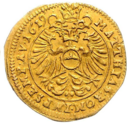
|
Mint: Detmold; Mint master: Melchior Kuttner |
| Edition: 1619 | |
| Material: gold; Diameter: 22.6 mm; Weight: 3.07 g | |
| Front: "SIMON COMES ET NOBI DOMINVS IN LIPPIA" around the coat of arms of the County of Lippe with a blanket and a crowned helmet | |
| Back: "I MATTHIAS ROM IMP SEMP AV 1619" double-headed about winning imperial eagle with orb | |
| Nominal: 1/24 thaler | |

|
Mint: Blomberg; Mint master: Caspar or Melchior Kohl |
| Edition: 1616 | |
| Material: silver; Diameter:?; Weight: ? | |
| Front: "1616" above and "24" in orb; all around "MATI * D * G * P * I * S * A" | |
| Reverse: heraldic rose above and Lippe coat of arms below the helmet; all around "SIM ?? ??? " | |
| Face value: 1/2 pfennig | |

|
Mint: Detmold; Mint master: Melchior Kuttner |
| Edition: 1622 or 1623 | |
| Material: copper; Diameter:?; Weight: ? | |
| Front: heraldic rose, each surrounded by five stars and dots | |
| Reverse: Value ("1" / "-" / "2") between two crowns and two lilies | |
Simon Ludwig (1627 to 1636)
Simon Ludwig (born March 14, 1610 in Brake ; † August 8, 1636 in Detmold of smallpox ) was not yet of age when his father died in 1627, so that his step-grandfather, Count Christian von Waldeck, was appointed his guardian. In 1627 the young count embarked on the customary cavalier tour that took him to Prague , France , England and the Netherlands . After his return in 1631, an application was made to the Emperor Ferdinand II for a declaration of majority .
Under the influence of his chancellor Christoph Deichmann , Simon Ludwig gradually gave up the cautious neutral policy of his deceased father and moved closer to Sweden . That brought him into disrepute among the imperialists. But the county of Lippe was not spared from the opposing party either; the Swedes demanded supplies like the imperial contributions. The count's family felt the hardship of the war burden even more clearly and directly than through uncomfortable official duties, so in 1634 Schwalenberg Castle and Varenholz Castle in 1636 were attacked and looted.
No coins were minted during the reign of Simon Ludwig.
Simon Philipp (1636 to 1650)
Like his brothers, Simon Philipp was still a child when his father died. His mother, Countess Katharina, strove to take over the guardianship of her sons, but since she was not of legal age at the age of 24, her father, Count Christian von Waldeck , should be brought in as guardian. But then Johann Bernhard , brother of the deceased count, announced the guardianship of his nephews and the regency in the country.
Fearing for the lives of her sons, Countess Katharina got in touch with the Hesse-Darmstadt troops who were in Lemgo and Rinteln at the time , and in 1638 a Hessian captain kidnapped the young princes and brought them to Lemgo and Hameln (" Prince robbery "). Later they were placed in the care of Landgrave Georg II of Hessen-Darmstadt in Marburg .
In 1645, the princes were brought to safety in Giessen to protect them from the war . Smallpox spread there, which is why Simon Philipp's younger brothers died in 1646. Then in 1647 his mother Katharina had her son “kidnapped” a second time. Count Simon Philipp returned to Detmold via detours. From 1649 Simon Philipp traveled to Paris , Grenoble , Rome , Milan and Florence. In Florence he fell ill with smallpox and died of it in 1650. Since he died without descendants, his uncle, Johann Bernhard, became the legal ruler of the County of Lippe.
| Overview of the coins | o. J. ≤1638 |
1638 | 1639 | o. J. ≥1644 |
anomalous nym |
| 1 gold guilder | G | ||||
| 2 Mariengroschen | S. | ||||
| 1/24 Taler (= 1 Reichsgroschen) | S. | S. | |||
| 6 pfennigs | K | K | |||
| 3 pfennigs | K | K | K | ||
| 2 pfennigs | K | K | K | ||
| 1 1/2 pfennigs | K * | ||||
| 1 pfennig | K | K | K | ||
| 1/2 pfennig | K | K |
Explanation: no year = no year, G = gold, S = silver, K = copper; * = see illustration
Johann Bernhard (1650 to 1652)
Johann Bernhard (* 1613; † 1652) was the second eldest son of Count Simon VII. Zu Lippe and Countess Anna Katharina von Nassau - Wiesbaden - Idstein . After the death of his nephew, Count Simon Philipp zur Lippe , he was sovereign of Lippe-Detmold from 1650 to 1652. He died childless.
Hermann Adolf (1652 to 1666)
Hermann Adolf (* 1616; † 1666) completed the expansion of Horn Castle in 1659 with a magnificent baroque portal above which the coats of arms of his family and his wife are attached. By sending a company of mercenaries, he took part in the fourth Austrian Turkish War in 1663/1664 .
| Overview of the coins | 1658 |
| 3 ducats | G |
| 1 thaler | S * |
| 1/2 thaler | S. |
| 1/4 thaler | S. |
| 4 Mariengroschen | S. |
| 2 Mariengroschen | S. |
Explanation: G = gold, S = silver: * = see illustration
Simon Heinrich (1666 to 1697)
Simon Heinrich zur Lippe-Detmold (* March 13, 1649 in Sternberg ; † May 2, 1697 in Detmold ) left the Lopshorn hunting lodge built by his father in 1657 in today's Augustdorf with a representative hunting lodge with symmetrical to replace the outbuildings arranged in a courtyard.
| Overview of the coins | 1671 | 1672 | 1673 | 1674 | 1681 | 1683 | 1685 | 1689 | 1692 | no year |
| 12 ducats | S. | |||||||||
| 10 ducats | G | G | ||||||||
| 9 ducats | S. | |||||||||
| 8 ducats | G | |||||||||
| 6 ducats | G | |||||||||
| 4 ducats | G | |||||||||
| 3 ducats | G | G | ||||||||
| 1 1/2 ducats | G | |||||||||
| 1 ducat | G | G | ||||||||
| 1 double thaler | S. | S. | ||||||||
| 1 thaler | S * | S. | S. | S. | ||||||
| 24 Mariengroschen | S. | |||||||||
| 1/3 thaler | S * | S. | ||||||||
| 1/4 thaler and cliff | S. | S. | ||||||||
| 6 Mariengroschen = 1/6 thaler | S. | S. | ||||||||
| 4 Mariengroschen | S * | S. | ||||||||
| 2 Mariengroschen | S. | |||||||||
| 1 Mariengroschen | S. | S * | S. | |||||||
| 1/24 thaler | S. | S. | ||||||||
| 1 Matthier | S. | S. | S. | |||||||
| 1 1/2 pfennigs | B. | |||||||||
| 1 pfennig = 1/6 Mariengroschen | B * | |||||||||
| 1/2 pfennig = 1/12 Mariengroschen | B. | |||||||||
| 1/2 pfennig | K |
Explanation: no year = no year, G = gold, S = silver, K = copper, B = billon; * = see illustration
Friedrich Adolf (1697 to 1718)
Friedrich Adolf (born September 2, 1667; † July 18, 1718) broke with the tradition of his predecessors to meet his military obligations to the Reich by paying subsidies and set up his own Lippe company . This has meanwhile been expanded to include battalion strength beyond what was required by the Reich . During his reign, however, the force was not used.
| Overview of the coins | 1710 | 1711 | 1712 | 1713 | 1714 | 1715 | 1716 | 1717 | no year |
| Medal of 10 ducats | G | ||||||||
| 10 ducats | G | ||||||||
| 5 ducats | G | G | G | ||||||
| Silver tee of it | S. | ||||||||
| 1 ducat | G | G | G | G | G | G | |||
| Silver strike of 1 1/2 ducats | S. | ||||||||
| Silver discount of 2/3 thalers | S. | ||||||||
| Silver tee of it | S. | ||||||||
| Copper tee of it | K | ||||||||
| 1 ducat medal | G | G | |||||||
| Silver tee of it | S. | ||||||||
| Gold discount of 1/48 thaler | G | G | |||||||
| 1/4 ducat | G | G | |||||||
| 1/4 ducat cliff | S. | ||||||||
| 1 thaler | S. | S. | S. | S. | |||||
| 2/3 thalers | S. | S. | S. | S. | S. | S. | S. | S. | |
| Copper tee of it | K | ||||||||
| 1/3 thaler | S. | S. | S. | S. | S. | S. | |||
| 1/4 thaler cliff | S. | ||||||||
| Copper tee of it | K | ||||||||
| 1/6 thaler | S. | S. | S. | S. | |||||
| 1/12 thaler | S. | S. | S. | S. | S. | S. | S. | S. | |
| 1 Mariengroschen | S. | S. | S. | S. | S. | S. | B. | ||
| 1/48 thaler | S. | S. | S. | S. | S. | S. | S. | ||
| Matthier | S. | S. | S. | S. | S. | S. | |||
| 3 pfennigs | K | ||||||||
| 2 pfennigs | K | ||||||||
| 1 1/2 pfennigs | K | ||||||||
| 1 pfennig = 1/6 Mariengroschen | ver. | ||||||||
| 1/2 pfennig | K |
Explanation: no year = no year, G = gold, S = silver, K = copper, B = billon; ver. = different metals used
Simon Heinrich Adolf (1718 to 1734)
Simon Heinrich Adolf (born January 25, 1694; † October 12, 1734) became famous for being in 1720 by Emperor Karl VI. in the Imperial Prince should be charged, but this could not be executed because it was not possible for him to procure the necessary costs to 4400 Reichstalern. A chronic financial shortage forced him in 1725 to sell the indebted Dutch rule Vianen and Ameide and to pledge Sternberg Castle to Hanover in 1733. In addition, Simon Heinrich Adolf took great care in the welfare of his country, vigorously promoting religion, custom, justice and the prosperity of all his subjects.
| Overview of the coins | 1718 | 1719 | 1720 | 1722 | 1724 | 1726 | 1727 |
| 1 ducat | G | G | |||||
| 1 thaler | S. | ||||||
| 2/3 thalers | S. | S. | S. | ||||
| Copper cut from it | K | ||||||
| 1/2 thaler cliff | S. | ||||||
| Gold strike from it | G | ||||||
| Copper cut from it | K | ||||||
| 1/3 thaler | S. | ||||||
| 1/6 thaler | S. | ||||||
| 1/12 thaler | S. | S. | |||||
| 1 Mariengroschen | S. | ||||||
| 1 Matthier | S. | ||||||
| 1 pfennig | K | ||||||
| 1/2 pfennig | K |
Explanation: G = gold, S = silver, K = copper
Simon August (1734 to 1782)
Until 1747 Simon August ruled under the tutelage of his mother Johanna Wilhelmine, daughter of Prince Georg August von Nassau-Idstein . Under the influence of the Enlightenment , he issued a new budget, social and legal system and, together with Adolf von Hillensberg, introduced the budget plan in Lippe in 1749 in order not to spend more than the income available. The Sparkasse Detmold and the Landesbrandversicherungsanstalt can be traced back to his first founding. He acquired the Salzuflen salt works and expanded Meinberg into a spa .
In 1753, during the reign of Simon August, the convention foot was introduced . Thereafter, the Principality of Lippe had the thaler as its currency : 1 thaler = 36 Mariengroschen = 288 pfennigs = 576 hellers . In contrast to other areas, the Batzen and the Kreuzer did not exist as currency in the Principality of Lippe.
| Overview of the coins | 1763 | 1764 | 1765 | 1766 | 1767 | 1768 | 1769 | 1770 | 1772 |
| 1 ducat | G | G | G | ||||||
| 1 thaler | S. | ||||||||
| 2/3 thalers | S. | S. | |||||||
| 1/3 thaler | S. | ||||||||
| 1/6 thaler | S. | S. | S. | ||||||
| 4 Mariengroschen | S. | ||||||||
| 1/12 thaler | S. | S. | S. | S. | S. | ||||
| 1/24 thaler | S. | ||||||||
| 1 Mariengroschen | S. | S. | S. | S. | S. | ||||
| 1/48 thaler | S. | ||||||||
| 1 Matthier | S. | S. | S. | S. | |||||
| 2 pfennigs | K | S. | S. | ||||||
| 1 pfennig | S / K | K | K | ||||||
| 1/2 pfennig | K | ||||||||
| 1 lighter | K | K | |||||||
| Silver cut from it | S. |
Explanation: G = gold, S = silver, K = copper
| Face value: 1 ducat | |
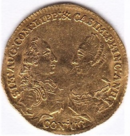
|
|
| Edition: 1769, for the wedding with Princess Casimire von Anhalt-Dessau on November 9th; Mint: Detomold (?); Mint master: probably Daniel Stümer | |
| Material: gold; Diameter: 20.4 mm; Weight: 3.48 g | |
| Front: SIM: AUG: COM: LIPP: & CASIM: PRINC: ANH around busts of the bride and groom | |
| Back: banner FELICITAS PUBLICA / two hands placed inside each other / NOV 9: 1769 | |
| Nominal: 1 Matthier | |

|
|
| Edition: 1766 | |
| Material:?; Diameter:?; Weight: ? | |
| Front: between two rosettes an "I" / "MATT." / "1766" / "B 3" (?) | |
| Reverse: heraldic rose, all around eight rosettes | |
| Face value: 1 convention thaler | |

|
|
| Edition: 1767, for the 41st birthday of Simon August on June 12, 1767 | |
| Material: silver; Diameter:?; Weight: ? | |
| Front: head looking to the right; all around "SIMON AUGUST COM. * IF. D. LIPP. SDV & ?? HVLTR. " | |
| Back: "QUEM" / "QUADRAGESIES ET" / "SEMEL PATRIAE" / "NATUM ESSE" / "GP ATULAMUR" / "d: XII Jun." / "MDCCLXVII" | |
| Note: This Lippe Taler is the only Lippe Taler ever minted according to the Convention Footing; but since the value is missing, it does not completely comply with the regulations! | |
| Nominal: 1 Heller | |
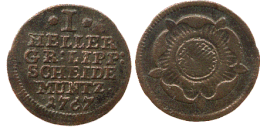
|
|
| Edition: 1767 | |
| Material:?; Diameter:?; Weight: ? | |
| Front: between two rosettes an “I” / “HELLER” / “GR. LIPP. "/" SCHEIDE "/" MUNTZ "/" 1767 " | |
| Reverse: heraldic rose | |
| Nominal: 1 Heller | |

|
|
| Edition: 1768 | |
| Material: copper; Diameter:?; Weight: ? | |
| Front: between two rosettes an “I” / “HELLER” / “GR. LIPP. "/" SCHEIDE "/" MUNTZ "/" 1768 " | |
| Reverse: heraldic rose | |
| Nominal: 1 Matthier | |
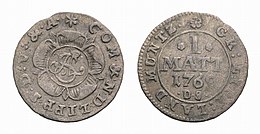
|
|
| Edition: 1769 | |
| Material:?; Diameter:?; Weight: ? | |
| Front: between two rosettes an "I" / "MATT." / "1769" / "B 3" (?); all around "* GR: LIPP: LAND MUNTZ" | |
| Reverse: "AS" in heraldic rose, all around "* COM & ND LIPP S: D: V & A" | |
| Nominal: 1/3 thaler | |
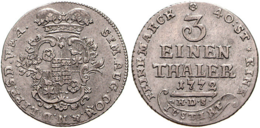
|
|
| Edition: 1772 | |
| Material: silver; Diameter:?; Weight: 7.73 g | |
| Front: "3" / "EINEN" / "THALER" / "1772" / "--------" / "HDS" / "IUSTIRE", all around "40: ST ** EINE FEINE MARCK" and rosette | |
| Back: Lippe coat of arms, four fields, under the crown; all around "SIM. AUG. COM. & ND LIPP. SDV & A. " | |
| Face value: 4 pfennigs | |

|
|
| Edition: 1784 | |
| Material:?; Diameter:?; Weight: ? | |
| Front: between two rosettes a "4" / "PFEN" / "NING" / "1784" / "D + S" | |
| Reverse: "LM * GL" around heraldic rose | |
Ludwig Heinrich Adolph (1782 to 1789), regent for Leopold I.
On March 13, 1786, Count Henrich Adolph zur Lippe established the first loan office regulation for the Count's Lippische Leihekasse zu Detmold. This laid the foundation stone. From May 1st, the tills were open to keep savings pennies safe and to give the citizens smaller loans. The old account books show that by the end of 1786 savings deposits totaling 26,432 Reichstalers had already been accumulated and almost the same amount of loans had been issued.
“By God's grace, we Ludwig Henrich Adolpf, Count and Noble Herr zur Lippe, Sovereign of Vianen and Ameiden, Hereditary Castle Count of Utrecht, etc., Knight of the Hessian Order of the Golden Lion, Guardian and Regent. Certificates and hereby acknowledge that we have accepted Balthasar Reinhard, who was previously in the service of Fürstlich Hessen Cassel as coin commissioner and mint master, as mint master and wardeln. (...) "
| Overview of the coins | 1783 | 1784 | 1785 | 1786 | 1789 |
| 1 Mariengroschen | S * | S. | S. | ||
| 4 pfennigs | S. | ||||
| 1 Matthier | S. | S. | |||
| 2 pfennigs | S. | ||||
| 1 lighter | K |
Explanation: S = silver, K = copper; * = see illustration
PRINCIPALITY OF LIPPE
Leopold I (1789 to 1802)
Wilhelm Leopold I (born December 2, 1767 in Detmold ; † April 4, 1802 in Detmold) was the first Prince of Lippe. On November 5, 1789, he took over the government and was the first to redeem the Prince's letter that his grandfather Simon Heinrich had applied for in 1720. In 1790 a mental disorder that had already been diagnosed in earlier years broke out and he was incapacitated by the Reich Chamber of Commerce ; In 1795 the guardianship was conditionally lifted after an improvement occurred. On January 2, 1796, he married Pauline von Anhalt-Bernburg . In this marriage the prince recovered and became the father of two sons. Pauline became his adviser and colleague, whereby she arranged it wisely, mostly stayed in the background and avoided everything that could be interpreted as exceeding her duties. After barely six years of marriage, the prince died of intestinal tuberculosis in 1802 , under the influence of which mental disorders and memory loss finally set in again. Pauline took over the reign of the still underage hereditary prince, the later Prince Leopold II. And was considered an excellent mother of the country.
| Overview of the coins | 1789 | 1790 | 1791 | 1792 | 1793 | 1794 | 1795 | 1796 | 1798 |
| 1 token (= 1 1/2 ducats) | G | ||||||||
| Silver tee of it | S. | ||||||||
| Copper tee of it | K | ||||||||
| 1 premium thaler | S. | ||||||||
| Copper tee of it | K | ||||||||
| Premium coin (at 1 guilder courant) | S. | ||||||||
| 1/12 thaler | S. | S. | |||||||
| 1 Mariengroschen | S. | S. | S. | S. | S. | ||||
| 1 Matthier | S. | S. | S. | S. | S. | ||||
| 1 pfennig | K | ||||||||
| 1 lighter | K | K |
Explanation: G = gold, S = silver, K = copper
Pauline (1802 to 1820)
Pauline (born February 23, 1769 in Ballenstedt as Princess of Anhalt-Bernburg ; † December 29, 1820 in Detmold ) is still one of the most important rulers in Lippe: On January 1, 1809, she raised the up to that existed serfdom of peasants, preserved the independence Lippes and sought a constitution with which the feudal order was broken. In the collective historical consciousness of the Lippe population, however, their social commitment ranks first. She founded the first children's institution in Germany, a vocational school for neglected children , a voluntary workhouse for adult alms recipients and a nursing home with an infirmary .
Leopold I died on April 4, 1802, and on May 18, Pauline took over the reign of her underage son, who later became Prince Leopold II .
| Grain prices from 1810 in thalers and groschen for a Lippe bushel (= 36.25 liters) | |||||
|---|---|---|---|---|---|
| items | Lemgo | horn | Blomberg | Salzuflen | Detmold |
| wheat | 1 T 25 3 / 4 G | 1 T 25 2 / 3 G | 1 T 23 G | 1 T 28 1 / 2 G | 1 T 28 1 / 4 G |
| rye | 1 T 8 1 / 6 G | 1 T 4 1 / 4 G | 1 T 5 1 / 2 G | 1 T 8 1 / 2 G | 1 T 8 3 / 4 G |
| barley | 35 1 / 2 G | 35 3 / 4 G | 35 1 / 4 G | 1 T 2 3 / 4 G | 1 T 2 3 / 4 G |
| oats | 60 2 / 5 G | 60 1 / 6 G | 50 1 / 4 G | 80 1 / 4 G | 69 3 / 5 G |
The "Leihekasse von 1786" is not the only forerunner of today's Sparkasse Detmold. In 1804 the "Leihbank" was founded under the government of Princess Pauline zur Lippe. The two institutes merged in 1909 to form the "Fürstlich-Lippische Landesspar- und Leihekasse in Detmold". The predecessors also include the "Sparkasse Horn-Bad Meinberg" from 1841, the "Stadtsparkasse Lage" from 1860, the "Städtische Sparkasse Barntrup" from 1883, the "Städtische Sparkasse Detmold" from 1904, the "Amtssparkasse / Kreissparkasse Lage" (Lippe) "from 1906, the" Städtische Sparkasse Schwalenberg "from 1914, the" Gemeindesparkasse Elbrinxen "from 1919 and the Amtssparkasse / Kreissparkasse Detmold" from 1920.
| Overview of the coins | 1802 | 1803 | 1804 | 1809 | 1812 | 1814 | 1816 | 1818 |
| 1 Mariengroschen | S. | S. | S. | |||||
| Gold discount of 1/2 ducats | G | |||||||
| 2 pfennigs | K | |||||||
| 1 pfennig | K | S. | ||||||
| 1 lighter | K | K | K | K | K | |||
| Silver tee of it | S. |
Explanation: G = gold, S = silver, K = copper
Leopold II (1820 to 1851)
Paul Alexander Leopold II (born November 6, 1796 in Detmold; † January 1, 1851 there) was only six years old when his father Leopold I died. Therefore, at the beginning of his reign in 1820, his extremely capable mother Pauline took over government until her death.
| Statutory distribution of the most important varieties before the introduction of the imperial currency | |||||
|---|---|---|---|---|---|
| Face value | Minting time | metal | Weight | Fine weight | Fineness |
| Double thaler | 1843 | silver | 37.120 g | 33,408 g | 900.0 ‰ |
| Club thaler | 1860, 1866 | silver | 18.519 g | 16.667 g | 900.0 ‰ |
| 2 1/2 silver groschen | 1847 | Billon | 3.248 g | 1.218 g | 375.0 ‰ |
| 2 1/2 silver groschen | 1860 | Billon | 3.221 g | 1.208 g | 375.0 ‰ |
| 1 silver groschen | 1847 | Billon | 1.559 g | 0.487 g | 312.5 ‰ |
| 1 silver groschen | 1860 | Billon | 2.196 g | 0.483 g | 220.0 ‰ |
| 1/2 silver groschen | 1847 | Billon | 0.974 g | 0.244 g | 250.0 ‰ |
Having come to the government, Leopold led a true hermit life. His wife, Princess Emilie von Schwarzburg-Sondershausen (born April 23, 1800), was a good, gentle woman who submitted to the strict way of life of her husband. The couple had nine children and had an exemplary family life. Leopold II had two passions, hunting and theater , which were among the best in Germany, but the costs of which were disproportionately high compared to the income of the state. Albert Lortzing was engaged at the Detmold Theater from 1826 to 1833.
| Annual living needs of a day laborer around 1849 | |
|---|---|
| House rent | 18 thalers |
| Garden rental | 6 thalers |
| Farmland to potatoes | 7 thalers |
| 1/2 bushel of bread grain per week | 26 thalers |
| Wages | 4 talers 10 silver groschen |
| legumes | 2 thalers |
| Wood | 10 thalers |
| coffee | 5 thalers |
| Fat, salt, oil | 10 thalers |
| Embedment fee | 1 thaler |
| total |
89 thalers 10 silver groschen |
| Annual salaries in selected occupations around 1850 | |
|---|---|
| job | salary |
| Wandering brick master | 300 ... 500 thalers |
| Ordinary teacher | not less than 150 thalers |
| Carpenter | 100 ... 110 thalers |
| Day laborers without food | 60 ... 84 thalers |
| Wandering goats | 45… 55 thalers |
| Day laborers with food | 31… 45 thalers |
| Foreman | 28 ... 38 thalers |
| Small servant | 20 ... 25 thalers |
| Grass mower | 18… 20 thalers |
In 1838 the state of Lippe joined the Dresden Minting Convention and in 1857 the Vienna Treaty. The minting took place - in accordance with these treaties - in Berlin.
| Overview of the coins | 1821 | 1822 | 1823 | 1824 | 1825 | 1826 | 1828 | 1829 | 1830 | 1835 | 1836 | 1840 | 1843 | 1847 |
| 2 thalers | S. | |||||||||||||
| 2 1/2 silver groschen | S. | |||||||||||||
| 1 silver groschen | S. | |||||||||||||
| 1/2 silver groschen | S. | |||||||||||||
| Copper tee of it | K | |||||||||||||
| 3 pfennigs | K | |||||||||||||
| Silver tee of it | S. | |||||||||||||
| 1 1/2 pfennigs | K | K | K | K | ||||||||||
| 1 pfennig | K | K | K | K | K | K | K | K | K | K | ||||
| 1 lighter | K | K | K | K | K |
Explanation: S = silver, K = copper
Leopold III. (1851 to 1875)
Paul Friedrich Emil Leopold III. (* September 1, 1821 in Detmold; † December 8, 1875 there) ruled from January 1, 1851 to December 8, 1875. As a strictly conservative , Leopold was an opponent of the March Revolution . He therefore soon dissolved the state parliament and, by decree of March 15, 1853, repealed the constitution of 1849 and reintroduced the constitution of 1836, although he was advised against it. The liberal party fumed over this coup d'état , while the prince took the position that he had neither initiated nor approved, let alone sworn to the constitution forced by the revolution. He then replaced his cabinet councilors with the ingloriously well-known Dr. Hannibal Fischer , the highly conservative “fleet fisherman”, who continued to make himself and the government extremely unpopular. His successor, the conservative minister Alexander von Oheimb , was nevertheless a great success in negotiating with the estates by separating the state and domanial budget in the interests of the prince and gaining the estates' recognition that the domanium was the private property of the princely Family was recognized. In general, however, the constitutional controversy continued, and the liberal opposition became even more excited about von Oheimb's success, making the prince's life angry and embittering him, while the rift between conservatives and liberals, between town and country, deepened. This certainly hurt the prince, for he was considered affable and friendly: everyone had access to his weekly audiences .
In 1875, the gold mark, introduced throughout the empire, also became a means of payment in the principality. The front, the obverse , could be designed by the member states of the empire. In Lippe they partly showed the portrait of the ruling prince.
| Overview of the coins | 1851 | 1858 | 1860 | 1866 |
| 1 club thaler | S. | S. | ||
| 2 1/2 silver groschen | S. | |||
| 1 silver groschen | S. | |||
| 3 pfennigs | K | |||
| 1 pfennig | K |
Explanation: S = silver, K = copper
Woldemar (1875 to 1895)
Günther Friedrich Woldemar (born April 18, 1824 in Detmold ; † March 20, 1895 there) was already 51 years old when he took office on December 8, 1875.
In view of his own childlessness, the incapacitated brother Karl Alexander zur Lippe and the resulting difficulties for the succession, he tried to prejudice the events. Due to personal aversion and inspired by the desire to bequeath his land to a member of a ruling princely house, in his will appointed Prince Adolf zu Schaumburg-Lippe , a brother-in-law of Emperor Wilhelm II , to be his successor and thus sparked the Lippe throne dispute that in the following decade in Lippe separated the spirits and aroused the interest of the world public.
No coins from Lippe were minted during Woldemar's reign until March 20, 1895.
Alexander (1895 to 1905)
Prince Karl Alexander (born January 16, 1831 in Detmold; † January 13, 1905 in St. Gilgenberg near Donndorf ) was nominally ruling Prince zur Lippe from March 20, 1895 to January 13, 1905 , but was incapacitated as a mentally ill person. To 1897 led Schaumburg-Lippe the regency, from 1897 Lippe-Biesterfeld , 1905 final Lippe-Biesterfeld. The changing reigns are also known as the Lippe succession dispute. With Alexander's death on January 13, 1905, the Detmold line of the Lippe Princely House died out.
No coins from Lippe were minted during Alexander's reign.
Leopold IV. (1905 to 1918)
Leopold IV. Julius Bernhard Adalbert Otto Karl Fritz Georg Gustav zur Lippe (born May 30, 1871 in Oberkassel near Bonn , † December 30, 1949 in Detmold) was the last ruling Prince of Lippe (1905 to 1918). Leopold's government was characterized by economic and cultural advancement, he was open to technology and industry. In order to offer the residents opportunities to earn a living, he had the state workshops set up and a large number of important building projects carried out. The magnificent buildings of the government and state parliament building, the savings banks and banks, the grammar school, the teachers' college, the Christ Church with the princely crypt on Kaiser-Wilhelm-Platz, the Protestant pastor's office, the barracks, the expansion of the castle, etc. served this purpose. In Bad Salzuflen he supported the drilling of the Leopold Spring with grants from his own budget. His most important creation is the Fürst-Leopold-Verwaltungsakademie: a university of applied sciences in which war-disabled officers were retrained to become municipal officials.
His great love was hunting and the theater , so he had the burned down court theater rebuilt in the middle of the First World War . He also devoted himself to popular education. The State School Act of 1914 created the state high school authority and eliminated the church's school supervision. The academy put the teachers on a par with the Prussian teachers . The new tax laws brought a fair distribution of the burdens and a substantial increase in tax revenue. The development of the country by road and rail promoted trade and traffic. Industrialization in particular made great strides. In the course of the November Revolution, Leopold IV was urged to renounce the throne on November 12, 1918 by the Lippe People's and Soldiers' Council.
| Overview of the coins | 1906 | 1913 |
| 2 Reichsmarks | S. | |
| 3 Reichsmarks | S. |
Explanation: S = silver
See also
literature
- Peter Berghaus : The beginnings of coinage in Lemgo and Lippstadt. In: Natural science and historical association for the land of Lippe (Hrsg.): Messages from the Lippe history and regional studies. Meyer, Detmold, 1952. p. 110 ff.
- Dieter Fassbender (arrangement); Paul Arnold, Harald Küthmann , Dirk Steinhilber (founder): Large German coin catalog from 1800 to today . 16th edition. Battenberg, Munich 2000, ISBN 3-89441-469-3 .
- Hermann Grote , Ludwig Hölzermann : Lippische money and coin history . Hahn, Leipzig 1867, urn : nbn: de: hbz: 51: 1-3732 .
- Heinrich Ihl: The coinage of the noblemen to the lip. Horn Mint . Lemgo 1995.
- Heinrich Ihl: The coinage of the noblemen to the lip. Lemgo Mint . Lemgo 1991.
- Heinrich Ihl, Arnold Schwede : The coinage of the counts and princes of the Lippe (1528-1913) (= studies and sources on Westphalian history ). Bonifatius , Paderborn 2016, ISBN 978-3-89710-641-3 .
- Franz Meyer (Ed.): Bad Salzuflen, Epochs of a City History . Publishing house for regional history, Bielefeld 2006, ISBN 3-89534-606-3 .
Web links
- Family tree graphic (PDF; 14.3 MB) historica-genealogie.com
- Personal data at nhv-Ahnenforschung.de
- Internet portal "Westphalian history"
Individual evidence
- ↑ The History of the Latin Monetary Union. Olten 2004.
- ↑ The mints. In: Heinrich Ihl, Arnold Schwede: The coinage of the counts and princes of the Lippe 1528–1923. Volume 1, pp. 32f.
- ↑ Horner Münzgeschichte at www.penke.info, accessed on April 6, 2020.
- ↑ Currency borders of the Westphalian Upper Weser region in the late Middle Ages. In: Walter Häverick (ed.): Numismatic studies. Issue 1, 1951, pp. 24/25.
- ↑ Contract of the nobleman Bernhard VII and the city of Lemgo with the mint master Dietrich von Neuss , accessed on January 10, 2014.
- ↑ St. Nicolai Lemgo, Reg. 10
- ↑ Citizens' Register of the City of Lemgo (Citizens Register) Book Register No. 8902 (City Archives Lemgo A526)
- ↑ Fire engine for the Wülfer fire department
- ↑ Fire engine for the Ottenhausen fire department
- ^ Hermann Grote, Ludwig Hölzermann: Lippische Geld- und Münzgeschichte. Leipzig 1867.
- ↑ Wardeine in Lippe. In: Heinrich Ihl, Arnold Schwede: The coinage of the counts and princes of the Lippe 1528–1923. Volume 1, pp. 36f.
- ↑ The way of counting money, coin feet, weights. In: Heinrich Ihl, Arnold Schwede: The coinage of the counts and princes of the Lippe 1528–1923. Volume 1, p. 38ff.
- ↑ Peter Berghaus : The beginnings of coinage in Lemgo and Lippstadt , in: "Messages from the Lippische Geschichte und Landeskunde", Detmold, 1952. P. 110; accessed on May 4, 2020.
- ^ Bernhard I. at genealogie-mittelalter.de ( Memento from May 2, 2003 in the Internet Archive )
- ↑ August Falkmann, Otto Preuß: Lippische Regesten. Volume 1, p. 74, no. 42.
- ↑ a b Hermann I. at genealogie-mittelalter.de ( Memento from May 2, 2003 in the Internet Archive )
- ↑ Gunther Wiegrebe Collection: The coins of the noble lords of the Lippe in the Middle Ages , Hermann II., 1197–1229
- ↑ collection Gunther Wiegrebe: The coins of the county Lippe since 1528
- ↑ Kurt Wallbaum: The districts of the large community Bad Salzuflen around 1535 in: "Heimatland Lippe" - magazine of the Lippischen Heimatbund and the Landesverband Lippe, No. 5/1988, Detmold, p. 39, accessed on May 1, 2020.
- ^ Heinrich Ihl: The coinage of the counts and princes of the Lippe 1528-1913. Volume 2: The Coins. Bonifatius-Verlag , Paderborn 2016, ISBN 978-3-89710-641-3 , chapter Coins of Count Simon V. (1511-1536), Count from 1528. P. 7.
- ^ Johann David Köhler: Historical coin amusements. Volume 22, p. 81.
- ↑ Description of the Guldengroschen at www.coingallery.de; accessed on March 17, 2020
- ^ Heinrich Ihl / Arnold Schwede: The coinage of the princes and counts of the Lippe 1528-1913 , volume 1, pages 23-25; Bonifatius Verlag, Paderborn, 2016.
- ↑ a b Sabine Schierholz: "Low German Corner" - "Daler un Grössens" . In: Lippische Landes-Zeitung , February 22, 2011.
- ↑ According to the legal situation at the time, the age of majority was reached only on completion of the 25th year of life.
- ↑ a b Sparkasse Detmold: Chronicle. ( Memento from December 18, 2012 in the web archive archive.today )
- ^ Founder of the first kindergarten: Pauline Fürstin zur Lippe. ( Memento from February 3, 2010 in the Internet Archive )
- ↑ Grain prices in the Fürstlich-Lippischen Intellektivenblatt , 51st issue, Saturday, December 22nd, 1810.
- ↑ Vaterländische Blätter, No. 7, 1849
- ^ C. Ehlers: Political and socio-economic driving forces of the revolution 1848/49 in Lippe. Muenster.
Coordinates: 51 ° 56 '9.9 " N , 8 ° 52' 38.3" E













